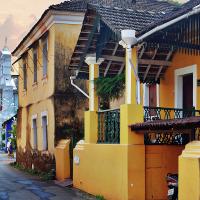Design Gallery
Houses of Goa
Portuguese Heritage
by
Heritage and classic Goan - Portuguese houses are found across various parts of Goa. While some are well maintained others remain abandoned and in a dilapidated condition. These houses are existing reminders of an art style that belongs to the late 1700's to early 1900's. As a legacy of the era of Portuguese colonization, these houses are not only symbols but they still remain occupied and alive due to some locals, who value and preserve these traditional mansions of their ancestral Goan aristocracy.
With houses dating back to the 1700's that are still immaculate and inhabited by the following generations it seems that unlike the other colonial powers in India, the Portuguese managed to leave a more visible mark on the residential architecture of the regions that they ruled. The Portuguese were inspired by European architectural styles. The houses in Goa remain confined to the rural areas such as Chandor and Loutolim. While the materials and constructions techniques remained local, the furnishings, decorations and ornaments came from across the world.
The walls and pillars of the house were built from red laterite stone and local wood. While the roof was overlaid with terracotta tiles coming from Mangalore. The inside of the house is festooned with porcelain from China and Macau, Cut - Glass and mirrors from Venice, chandeliers from Belgium and tapestries from Portugal. The exquisite Rosewood furniture was carved by the local craftsmen.
Just as the exterior facade of these mansions is attractive, the interiors make a much more impressive sight with their own mini - chapels and dance rooms. There are long and well preserved dining rooms, the drawing rooms usually boast of a magnificent collection of blue china ceramics and glass artefacts.

The house is a fine example of the amalgamation of two cultures and the high living of the Goan landed gentry of the period. One of Goa's largest heritage homes, the Figueiredo house in Loutolim, South Goa, built in 17th century was recently thrown open to the public as a museum in collaboration with the Xavier Centre of Historical Research, Goa. The remarkably maintained Casa MuseuVincento Joao de Figueiredo represents a curious melange of Indo-Portuguese History.

Loutolim, South Goa; Built in 19th century. Luxurious country houses with handsome verandas surrounded by exuberant palm groves and verdant fields. Introduced by the Portuguese, the Goan balcony eventually played a significant role in ensuring a more socially oriented Goan house. This house has porches with large staircases.

White house at Saligao, North Goa; Built in 17th century. This rendering in white is the result of the unwritten rule during the Portuguese occupation of Goa that no private house or building could be painted in white. Only churches and chapels enjoyed this privilege. However, this was not completely a matter of individual choice, since during Portuguese rule the owner of the house could be fined if his house was not painted.

Nagoa, North Goa; Built in 19th century. The traditional Hindu houses of Goa reflect several millennia of old Indian Architectural heritage. The use of nacre, the mother-of-pearl shell was preferred over glass as it allowed for a subdued filtered light to come into rooms of the house while affording privacy. This gave windows in Goan homes a warm translucent look from the outside while cutting off the sunlight's glare on the inside.

Casa Robello, Anjuna, Goa, Built in 16th Century. This royal blue Goan house is classic due to its characteristic balconies. The seats along the length of the porch are L-shaped and made from expensive wood. The windows have brightly coloured stained glass and contrasting it are lightly tinted flint glass that are no longer made in such a creative manner.

House at Fontainhas is locally called Mala, Panjim, Goa; Built in 19th century. The covered porches of this house are bordered by ornamental columns that sometimes continue along the steps and are added to the stature of the house, which usually indicated the status of the owners. The houses of rich landlords had high plinths with grand staircases leading to the front door or covered porches.

Old Heritage Inn, South Goa; Built in 18th century. The old part of the Figueiredo house with its dark brooding rooms dates back to 1604. Maria Figueiredo ran a Heritage Inn here for some years; they were built 200 years later. In this mansion many of the artefacts were custom made and reflect the confluence of two traditions, Hindus and Portuguese that has been the hallmark of Goa Architecture.

Shioli, North Goa, built in 18th century. This mansion reveals the care that went into the planning of the entrance of a house. The mansion had a well-kept garden, the green pleasantly contrasting the deep yellow of the masonry seats. They broke the monotony of the yellow wash and the outer wall that is interspersed with decorative tiles.

House at Arpora, North Goa. Almost all Goan houses have a false ceiling of wood. The Catholic houses built or refurbished between the middle of the 18th and the 20th centuries were more outward-looking and ornamental, with covered porches locally knows an 'balcoes' and verandas facing the street. The large balcoes had built-in seating, open to the street, where men and women could sit together and 'see and be seen', chat with their neighbours, or just enjoy the evening breeze.














